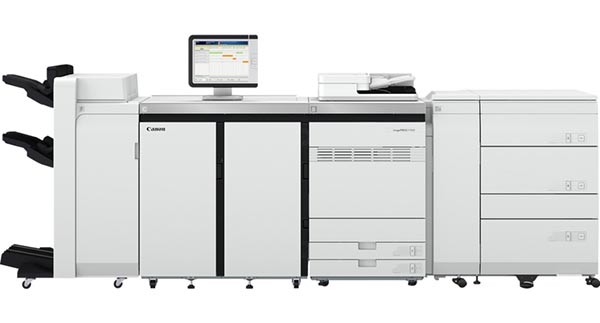
This article is sponsored by Canon as part of WhatTheyThink’s Digital Product Spotlight series. In preparing this article, the WhatTheyThink editors conducted original, in-depth research on Canon’s imagePRESS V1000. This Product Spotlight describes what the editors feel are the product’s strengths in the marketplace. Canon reviewed the final article for accuracy but had no editorial control over the content.
Background
Canon introduced their first digital color toner presses, the entry level imagePRESS C1 and the high production cutsheet imagePRESS C7000VP in 2006, and they have been developing and manufacturing digital presses with new and innovative features ever since. As a result, they are one of the global leaders in production digital printer manufacturing. Their latest introduction is the imagePRESS V1000, and with it comes significant engineering developments that make this press a high quality and high performance press that addresses their customers’ needs and checks all the boxes.
Consistent Quality and Ease of Use
Designing a digital press for today’s market requirements can be a challenge. In addition to ensuring high productivity and quality, since labor and media are increasingly hard to come by, the press has to be easy to operate and provide inherent consistency. The imagePRESS V1000, Canon’s latest production digital press is the result of years of customer feedback and engineering ingenuity. It focuses on productivity, cost control, automation, quality and ease of use, individually and collectively. This was accomplished by automating many of the key operational technologies. While there are many unique developments in this new press, there are a few key areas that highlight the design advantages.
Productivity
The imagePRESS V1000 is rated at speed of 100 ppm, with a peak monthly volume of 600,000 pages, however, the rated speed of a press is based on continuous printing. Depending on whether you are feeding 40# text, 150# cover stock, envelopes or magnets, each with its own characteristics, the feeding and imaging can be affected. If you are duplexing, it just compounds the potential issues, especially if it is a 51-in. long sheet. Canon engineers addressed this with a number of unique developments in the press.
Media Control
The new Precision Registration technology dramatically improves sheet to sheet and front to back registration. It does this through a very unique combination of technologies.
As a paper enters the press, it does the first of four registration checks with the compact registration unit, initially introduced in their C910 press, where it does a skew adjustment and alignment check. This ensures it is on a straight paper path prior to the toner transfer to the paper.
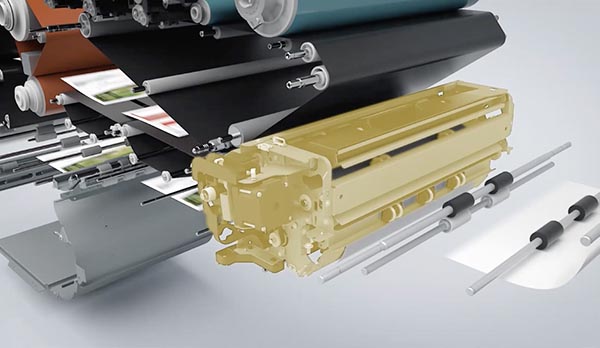
The first of four registration checks.
After imaging and before duplexing, it goes through a secondary duplex mechanical alignment check and flips the paper.

A secondary duplex mechanical alignment check.
The paper then goes through a third alignment and skew check before it goes back through the compact registration unit again prior to imaging the second side.
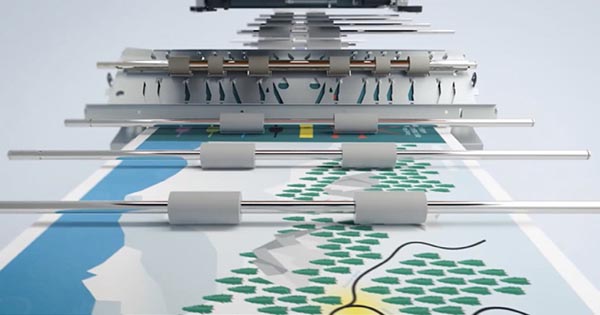
The paper goes through a third alignment and skew check.
So the Precision Registration system ensures sheet to sheet and front to back alignment and consistency by checking and fixing multiple times.
The transport and imaging on light weight paper is different, this is where all of most print engines are very different in how they transfer the toner to the paper. In the case of Canon if you open up the C910 you’d see a secondary transfer roller. It’s a secondary transfer roller. If you open up the C10010, you’d see a secondary transfer belt. The roller is better for lightweight papers because, there can be a lot of static electricity where the imaging contact takes place and the media might not want to let go, so by putting the path at sharper angles it can separate easily. For heavyweight papers, if you keep the paper feed at an angle you might get trail end fading.
The V1000 addresses this issue with Dynamic Transfer technology, which supports both lightweight and heavy weight stocks and switches between them. It is accomplished by using an adjustable metal plate that can automatically adjust the feed from an angle to flat depending on the media weight. So you’re getting truly the best of both worlds. You’re getting the reliability for lightweight and optimal toner transfer on heavyweight papers, and it does this with a flexible transfer belt for peak laydown of tints and solids. Importantly, the operators don’t need to do anything since the press does all the work.

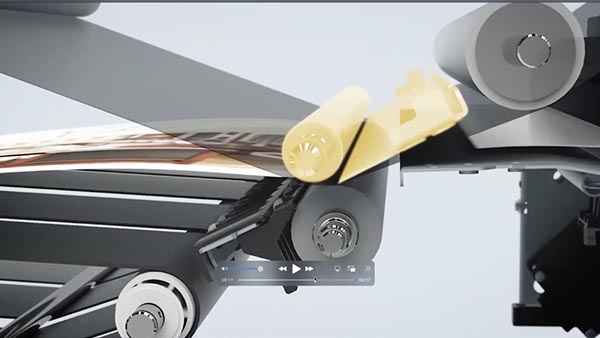
Dynamic Transfer technology supports both lightweight and heavy weight stocks and switches between them.
One of the other media control technologies incorporated is the Paper Conditioner. Since the toner bonding to the media is a heat driven process, digital presses need to cool the media down for subsequent operations, whether that be duplexing or exit and finishing. The V1000 uses, what is in essence a heat sink which absorbs about 30% of the residual heat in the paper without the need for chemicals or additional energy consumption. This helps with minimizing paper curl on thin stocks, and “bricking” when printing on heavy and coated stocks.
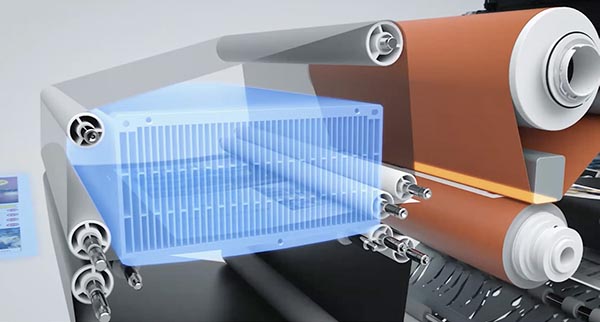
Paper Conditioner
Imaging Control
Ensuring consistent imaging across the sheet or from sheet to sheet on any media weight or surface can be a challenge. The V1000 starts with the new POD-SURF (Surface Rapid Fusing) technology, which provides consistent imaging regardless of the paper weight or surface condition at rated speed. It is able to accomplish this by providing a consistent dwell time and temperature.
In order for the belt in any type of fusing unit to work it needs to get to a certain temperature for it to properly fuse the toner onto the paper. The problem is that as you transfer to heat to the paper the belt cools down significantly as you can see in the diagram below. So the solution was to start with a larger heating roller with more heating elements, a slightly larger and more durable heating belt and a larger fusing area. This allows the belt to rebound or heat back up before it gets to the next paper. The contact area is quite large and you don’t have the pressure of a roller on top of roller which can affect the surface of the paper, especially on textured papers like felt and linen and flatten out the texture.

It uses a larger heating roller with more heating elements.
While fusing is important, so is providing accurate and consistent color throughout a press run. The imagePRESS V1000 does this through a number of new and automated technologies. Consistency is provided by the Multi-DAT technology on the V1000. The press automatically measures 20 color patches (20,40,60, 80,100) every minute or 101 pages with built in densitometers. The CMY patches are measured directly on the transfer belt and K on the drum, all without any operator involvement. If it reads outside of tolerance the press will adjust, and if it reads way out of tolerance it will notify the error to the operator.

Consistency is provided by the Multi-DAT technology on the V1000.
Color accuracy is achieved with the ILS (Inline Spectrophotometer) technology. This built in system, which consists of four spectrophotometers across the engine width does an engine linearization upon operator initiation. It can also do profiling and G7 characterization whether you have the PRISMAsync or Fiery controller, all without the need for operator involvement other than to initiate. It automatically prints all of the patches and measures them usually in under 5 minutes. So you no longer need to do an external profiling each time you introduce a new paper, and importantly you don’t need to have the color management skills.
In keeping with the ease of use theme, the V1000 even makes changing toner easy. If you are in need of toner, when you open the cabinet door the door of the toner needing attention opens automatically so you can easily determine which one to change without stopping the run.
And Customers Love It
Canon customers really appreciate technology advancements of the V1000, in fact Corey Greco, President at GCP Print and Visual Communications said “I love the V1000 engine and am producing amazing work.”
















Discussion
Only verified members can comment.